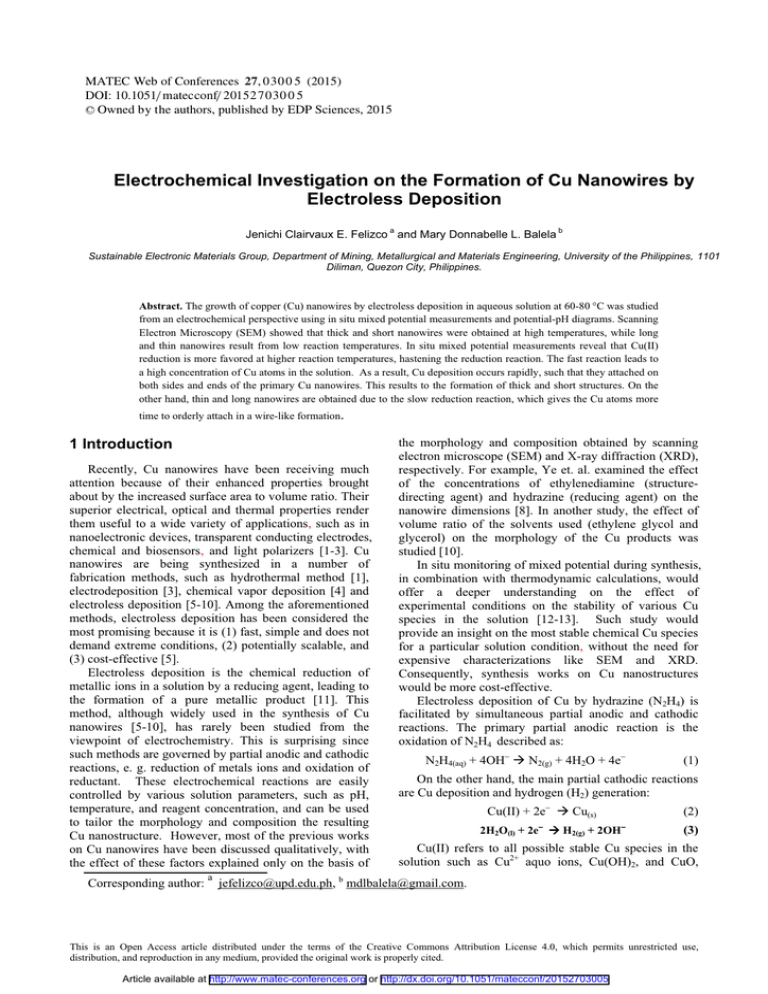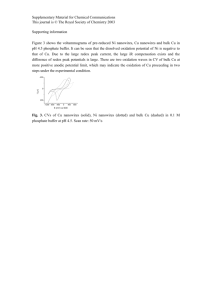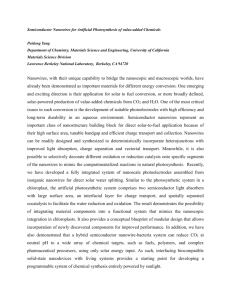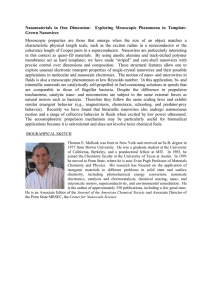Electrochemical Investigation on the Formation of Cu Nanowires by Electroless Deposition
advertisement

MATEC Web of Conferences 27, 0 3 0 0 5 (2015) DOI: 10.1051/ m atec conf/ 201 5 2 7 0 3 0 0 5 C Owned by the authors, published by EDP Sciences, 2015 Electrochemical Investigation on the Formation of Cu Nanowires by Electroless Deposition Jenichi Clairvaux E. Felizco a and Mary Donnabelle L. Balela b Sustainable Electronic Materials Group, Department of Mining, Metallurgical and Materials Engineering, University of the Philippines, 1101 Diliman, Quezon City, Philippines. Abstract. The growth of copper (Cu) nanowires by electroless deposition in aqueous solution at 60-80 °C was studied from an electrochemical perspective using in situ mixed potential measurements and potential-pH diagrams. Scanning Electron Microscopy (SEM) showed that thick and short nanowires were obtained at high temperatures, while long and thin nanowires result from low reaction temperatures. In situ mixed potential measurements reveal that Cu(II) reduction is more favored at higher reaction temperatures, hastening the reduction reaction. The fast reaction leads to a high concentration of Cu atoms in the solution. As a result, Cu deposition occurs rapidly, such that they attached on both sides and ends of the primary Cu nanowires. This results to the formation of thick and short structures. On the other hand, thin and long nanowires are obtained due to the slow reduction reaction, which gives the Cu atoms more time to orderly attach in a wire-like formation. 1 Introduction Recently, Cu nanowires have been receiving much attention because of their enhanced properties brought about by the increased surface area to volume ratio. Their superior electrical, optical and thermal properties render them useful to a wide variety of applications, such as in nanoelectronic devices, transparent conducting electrodes, chemical and biosensors, and light polarizers [1-3]. Cu nanowires are being synthesized in a number of fabrication methods, such as hydrothermal method [1], electrodeposition [3], chemical vapor deposition [4] and electroless deposition [5-10]. Among the aforementioned methods, electroless deposition has been considered the most promising because it is (1) fast, simple and does not demand extreme conditions, (2) potentially scalable, and (3) cost-effective [5]. Electroless deposition is the chemical reduction of metallic ions in a solution by a reducing agent, leading to the formation of a pure metallic product [11]. This method, although widely used in the synthesis of Cu nanowires [5-10], has rarely been studied from the viewpoint of electrochemistry. This is surprising since such methods are governed by partial anodic and cathodic reactions, e. g. reduction of metals ions and oxidation of reductant. These electrochemical reactions are easily controlled by various solution parameters, such as pH, temperature, and reagent concentration, and can be used to tailor the morphology and composition the resulting Cu nanostructure. However, most of the previous works on Cu nanowires have been discussed qualitatively, with the effect of these factors explained only on the basis of Corresponding author: a the morphology and composition obtained by scanning electron microscope (SEM) and X-ray diffraction (XRD), respectively. For example, Ye et. al. examined the effect of the concentrations of ethylenediamine (structuredirecting agent) and hydrazine (reducing agent) on the nanowire dimensions [8]. In another study, the effect of volume ratio of the solvents used (ethylene glycol and glycerol) on the morphology of the Cu products was studied [10]. In situ monitoring of mixed potential during synthesis, in combination with thermodynamic calculations, would offer a deeper understanding on the effect of experimental conditions on the stability of various Cu species in the solution [12-13]. Such study would provide an insight on the most stable chemical Cu species for a particular solution condition, without the need for expensive characterizations like SEM and XRD. Consequently, synthesis works on Cu nanostructures would be more cost-effective. Electroless deposition of Cu by hydrazine (N2H4) is facilitated by simultaneous partial anodic and cathodic reactions. The primary partial anodic reaction is the oxidation of N2H4 described as: N2H4(aq) + 4OH− N2(g) + 4H2O + 4e− (1) On the other hand, the main partial cathodic reactions are Cu deposition and hydrogen (H2) generation: Cu(II) + 2e− Cu(s) − (2) − 2H2O(l) + 2e H2(g) + 2OH (3) Cu(II) refers to all possible stable Cu species in the solution such as Cu2+ aquo ions, Cu(OH)2, and CuO, jefelizco@upd.edu.ph, b mdlbalela@gmail.com. This is an Open Access article distributed under the terms of the Creative Commons Attribution License 4.0, which permits unrestricted use, distribution, and reproduction in any medium, provided the original work is properly cited. Article available at http://www.matec-conferences.org or http://dx.doi.org/10.1051/matecconf/20152703005 MATEC Web of Conferences among others. The mixed potential is the potential at the point where the sum of all the anodic currents (Ia) and cathodic currents (Ic) due to all partial anodic and cathodic reactions become equal [12-13]. The stable Cu species can be determined when potential-pH diagrams are constructed based on current solution condition and then compared to the kinetically measured mixed potential. Varying the mixed potential of the system, on the other hand, can lead to control over which Cu species are produced. In this work, the growth of Cu nanowires in aqueous solution at increasing temperature is electrochemically investigated by in situ mixed potential measurements. These measurements are then compared with the calculated oxidation-reduction potential of Cu(II)/Cu redox pair. Potential-pH diagrams were constructed at different reaction temperatures and pH to determine the reaction conditions at which certain Cu species exist. 2 Experimental 2.1 Synthesis of Copper Nanowires This method was adopted from Wiley et al [14]. In a 1000 ml round bottom flask, 200 mL of 15 M sodium hydroxide [NaOH, RCI Labscan] and 10 mL solution of 0.1 M copper nitrate hemi(pentahydrate) [Cu(NO3)2•5H2O, Sigma Aldrich] were mixed. Then, 1.5 mL ethylenediamine [EDA, Sigma Aldrich] and 0.25 mL hydrazine [N2H4, 35 wt%, Sigma Aldrich] were added to the solution while stirring at 200 rpm. The solution was then heated to increasing reaction temperatures (60, 70 and 80 °C) for 5 min. Then, 25mL of 0.46 mM poly(vinylpyrrolidone) aqueous solution [PVP, 10,000 MW, Sigma Aldrich] was gently added on top. The flask was then placed in an ice bath for 1 h. The nanowires were collected by centrifugation and washed with 3 wt.% N2H4 solution. After several washings, the Cu NWs were then stored in 25mL storage solution containing 1wt% PVP and 3wt% N2H4 aqueous solution. Morphological analaysis of the Cu products was performed using scanning electron microscope (SEM, JEOL 5300). Structural analysis was done using X-ray diffraction (XRD, Shiamdzu XRD-7000). 2.2 Electrochemical nanowire deposition Investigation of Cu During the 5 min heating time, in-situ mixed potential measurement was done in a potentiostat/galvanostat [Autolab PGSTAT128N] using a two-electrode cell set up with Pt sheet (0.5x20x20cm) as the working electrode and a double-junction Ag/AgCl electrode [Metrohm] as the reference electrode. 3 Results and discussion The SEM images of the Cu nanowires formed by electroless deposition at 60 - 80 °C are shown in Fig. 1. Only Cu nanowires were obtained at all reaction temperatures. The Cu nanowire lengths were measured to be about 18.5, 19.8 and 12.9 µm for reaction temperatures of 60º, 70º and 80ºC, respectively. On the other hand, the diameters were 63, 101 and 129 nm. A huge increase in the nanowire aspect ratio from 100 to 294 was observed when the temperature was decreased from 80 to 60ºC. It is possible that nucleation was more favored at higher temperatures. In the presence of many nuclei, the distance between two nuclei is relatively short, increasing the chances for collisions. Consequently, anisotropic growth of Cu nuclei would be more difficult, and short and thick Cu nanowires were produced. At lower temperatures, there are fewer Cu nuclei in the solution and the slow reaction rate allows the wire-like growth of Cu. Thus, long and thin Cu nanowires were obtained. Figure 1. SEM Images of Cu nanowires formed by electroless deposition in aqueous solution at (a) 60ºC, (b) 70ºC, (c) 80ºC The corresponding XRD patterns of Cu nanowires formed at increasing reaction temperatures are shown in Fig. 2. Highly crystalline peaks are observed at 43.5, 50.6 and 74.3 which are attributed to the 111, 200 and 220 peaks of face-centered cubic (fcc) Cu (JCPDS Card No. 04-0836, a=0.3615 nm). The absence of any other peaks, e.g. Cu oxides and/or hydroxide, suggests that pure metallic Cu is obtained. Using the Scherrer’s equation, the crystallite sizes of the Cu nanowires were determined from the broadening of the 111 peak. The calculated values for the Cu nanowires formed at reaction temperatures of 60 and 80are about 43.44 and 53.65 nm, respectively. This agrees well with the apparent diameter of the Cu nanowires measured from the SEM 03005-p.2 ICEIM 2015 images in Fig.1. Generally, higher reaction temperature leads to the formation of larger crystals, and in effect, thicker nanowires. Figure 2. XRD Pattern of Cu nanowires formed at reaction temperatures of (a) 60ºC and (b) 80ºC. To further understand the Cu(II) reduction process, electrochemical investigation was performed using mixed potential measurements. Fig. 3 shows the change in mixed potential of the solutions with time at varying reaction temperatures. The horizontal lines indicate the calculated oxidation-reduction potential of Cu/Cu(II) redox pair, under the assumption that Cu2+ aquo ions are in equilibrium with CuO. As can be observed in the plots in Fig. 3, the mixed potential values are more negative than the calculated oxidation-reduction potential of Cu/Cu(II) even at the early stages of the reaction. This suggests that Cu(II) reduction occurs almost instantaneously upon reaching the target temperature. It is possible that the large concentration of OH− in the solutions significantly affects the total reaction rate. The reducing power of N2H4 is known to increase at high pH, which could explain its efficacy as reducing agent for Cu(II) in the present work [15]. On the other hand, increasing the temperature leads to an obvious decrease in the mixed potentials of the solutions. Additionally, the mixed potentials become more negative than the Cu/Cu(II) oxidation-reduction potential as the temperature is raised. This suggests an enhanced driving force for Cu(II) reduction at higher temperatures. A possible explanation would be the faster oxidation of N2H4 at higher temperatures [15]. Since the oxidation of N2H4 is favored, more electrons are produced to facilitate the reduction of Cu(II) ions to metallic Cu. More Cu atoms are deposited at a time. As a result, thick and short Cu nanowires are formed as in Fig. 1(c). Figure 3. Mixed potential measurements at varying reaction temperatures. (a) 60ºC, (b) 70ºC, (c) 80ºC Potential-pH (Eh-pH) diagram for each solution condition experimented was constructed using the thermodynamic values in Table 1 and compared to the measured mixed potentials obtained during the 5 min reaction time. Eh-pH diagrams were calculated for reaction temperatures 60˚, 70˚and 80˚, having pH values of 12.8, 12.6 and 12.2, respectively. The measured pH of the solution decreased with increasing reaction temperature because the ionic product (Kw) for water increases at elevated temperatures. In the construction of the Eh-pH diagrams, only the species Cu2+, Cu, Cu2O and CuO were considered for simplicity. As shown in Fig. 4, the mixed potential values for each corresponding temperature were plotted against the constructed Eh-pH diagrams. For all cases, the mixed potential values were determined to lie within the Cu stability region. This suggests that Cu reduction certainly occurred in all reaction temperatures, which is in agreement with the XRD results in Fig. 2. 03005-p.3 MATEC Web of Conferences Figure 4. Potential-pH diagrams of Cu at reaction temperatures of (a) 60ºC, (b) 70ºC, (c) 80ºC. Table 1. List of Thermodynamic Data [13-14]. Chemical Species Cu2+(aq) Cu(s) Cu2O(s) CuO(s) H+(aq) H2O(l) Standard Heat of Formation (ΔH, kJ mol-1) 64.4 0.0 -167.4 -155.2 0.0 -285.5 Standard entropy (S, JK-1mol-1) -98.7 33.1 93.1 42.7 0.0 70.0 4 Summary Specific heat at constant pressure (JK-1mol-1) Cp = a + bx10-3T 267.8 0.0 22.6 6.3 62.3 23.9 38.8 20.1 129.7 0.0 75.4 0.0 References The growth of Cu nanowires by electroless deposition in an aqueous solution at increasing temperature was examined from an electrochemical perspective using in situ mixed potential measurements and potential-pH diagrams. SEM images reveal that thick and short Cu nanowires are produced at higher reaction temperatures. These nanowires are composed of large Cu crystals as determine from the broadening of the XRD peaks. On the other hand, the mixed potential shifted more negatively with time at higher temperatures. This suggests larger driving force for Cu(II) reduction, which generate thick Cu nanowires. Additionally, the measured mixed potential lies within the metallic Cu stability region in the constructed potential-pH diagrams. This suggests that Cu(II) reduction instantaneously occurred in the solution, leading to the formation of metallic Cu nanowires. 1. 2. 3. 4. 5. Acknowledgments The authors would like to thank the Department of Science and Technology-Engineering Philippine Council for Industry, Energy and Emerging Technology Research and Development (DOST-PCIEERD) and the Engineering Research and Development for Technology (ERDT) for the research assistance. The authors would also like to thank the College of Engineering, University of the Philippines for the Professorial Chair Award 20142015. 6. 7. 03005-p.4 Y. Zhao, Y. Zhang, Y. Li, and Z. Yan, "Soft synthesis of single-crystal coppernanowires of various scales," New J. Chem., 36, pp. 130-138, 2012. H. S. Virk, "Fabrication and Characterization of Copper Nanowires. pdf," in Nanowires Implementations and Applications, A. Hashim, Ed., ed: InTech, 2011. Y. Deng, N. Wang, H. Ling, and M. Li, "Synthesis of Copper Nanowires on the Substrates in Aqueous Solution," IEEE, 2013. H. Choi and S. Park, "Seedless Growth of FreeStanding Copper Nanowires by Chemical Vapor Deposition," Journal of American Chemical Society, 126, pp. 6248-6249, 2004. C. Xu, Y. Wang, H. Chen, R. Zhou, and Y. Liu, "Large-scale synthesis of ultralong copper nanowires via a facile ethylenediamine-mediated process," Journal of Materials Science: Materials in Electronics, 25, pp. 2344-2347, 2014. Y. Chang, M. Lye, and H. Zeng, "Large-Scale Synthesis of High-Quality Ultralong Copper Nanowires," Langmuir, 21, pp. 3746-3748, 2005. A. R. Rathmell, S. M. Bergin, Y. L. Hua, Z. Y. Li, and B. J. Wiley, "The growth mechanism of copper nanowires and their properties in flexible, transparent conducting films," Adv Mater, 22, pp. 3558-63, Aug 24 2010. ICEIM 2015 8. S. Ye, Z. Chen, Y. C. Ha, and B. J. Wiley, "Realtime visualization of diffusion-controlled nanowire growth in solution," Nano Lett, 14, pp. 4671-6, Aug 13 2014. 9. S. Ye, A. R. Rathmell, I. E. Stewart, Y. C. Ha, A. R. Wilson, Z. Chen, et al., "A rapid synthesis of high aspect ratio copper nanowires for high-performance transparent conducting films," Chem Commun (Camb), 50, pp. 2562-4, Mar 11 2014. 10. Z. Yin, S. Song, D. You, Y. Ko, S. Cho, J. Yoo, S. Park, Y. Piao, S. Chang, and Y. Kim, "Novel Synthesis, Coating, and Networking of Curved Copper Nanowires for Flexible Transparent Conductive Electrodes", Small (2015) pp. 1-8. 11. S. Djokic, "Electroless Deposition of Metals and Alloys", 35, New York, USA: Kluwer Academic/Plenum Publishers, 2002. 12. S. Yagi, "Potential-pH Diagrams for Oxidation-State Control of Nanoparticles Synthesized via Chemical Reduction," in Thermodynamics - Physical Chemistry of Aqueous Systems, D. J. C. M. Piraján, Ed., ed: InTech, 2011. 13. S. Yagi, H. Nakanishi, T. Ichitsubo, and E. Matsubara, "Oxidation-state Control of Nanoparticles Synthesized via Chemical Reduction using Potential Diagrams", J. Electrochem. Soc., 156, 8, (2009), pp. D321-D325. 14. B. J. Wiley and A. R. Rathmell, "Compositions and Methods of Growing Copper Nanowires," USA Patent, 2013. 15. G. MacNaughton, G. Urda, and S. Bowden, "Oxiation of Hydrazine in Aqueous Solutions", Civil and Environmental Engineering Development Office Tyndall AFB FL Detachment 1, No. CEEDO-TR-7811, (1978). 03005-p.5








